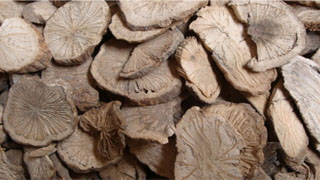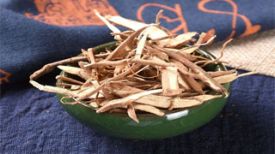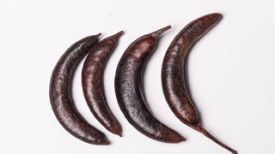
1. Alias
Golden Key, Wood Incense, Green Vine Root, Green Sandalwood.2. Plant morphology
Wooden vine. The tender branches are densely covered with soft fur, while the old branches are almost hairless, with straight lines on the surface. Single leaf mutualism; The petiole is 1-3 centimeters long and covered with white soft hairs; The leaves are papery to nearly leathery, with great variation in shape, ranging from linear lanceolate to broadly ovate nearly circular, narrowly elliptical to nearly circular, oblancephalose to inverted heart-shaped, sometimes ovate heart-shaped, measuring 3-8 cm in length, with a few exceeding 10 cm, and 1.5-5 cm in width. The tips are gradually pointed, acute, or blunt with small convex tips, sometimes slightly lobed or 2-lobed, and the base is wedge-shaped, round, or heart-shaped. The edges are entire or 3-lobed, sometimes palmately 5-lobed, and both surfaces are covered with dense to sparse soft hairs, sometimes both surfaces are nearly hairless. The inflorescence is solitary or arranged in a cone-shaped manner, axillary or terminal, up to 10 centimeters or longer, covered in soft hairs; Monoecious flowers, dioecious plants; Male flowers pale yellow; Sepals 6, hairless, outer ring ovate or elliptical ovate, 1-2 mm long, inner ring broadly elliptical, up to 2.5 mm long; Petals 6, needle shaped oblong in shape, with a 2-lobed tip and ears on both sides of the base, folded inward, measuring 1-2 millimeters in length; Stamen 6, shorter than petals; The sepals and petals of female flowers are similar to those of male flowers; Degenerated stamen 6, tiny; Heart skin 6. The drupe is nearly spherical, purple red or blue black when ripe, and measures 7-8 millimeters in length. Flowering period from May to August, fruiting period from August to October
3. Origin distribution
Born on slopes, shrubs, forest edges, roadsides, or sparse forests. Distributed in East China, Central South, Southwest China, as well as Hebei, Liaoning, Shaanxi and other places, especially common in the Yangtze River Basin and its southern regions.
4. Harvesting and processing
Harvesting is done in spring and autumn, with autumn yielding better quality. Roots are harvested, stems, leaves, and reed heads are removed, washed, and dried.
5. Characteristics of medicinal herbs
The root is cylindrical or twisted, slightly protruding in a bead like shape, 10-20 centimeters long, and 1-2.5 centimeters in diameter. The surface is black brown, with curved longitudinal grooves and a few branch root marks, hard texture, yellow white cross-section, radial texture and small holes. The air is faint and the taste is slightly bitter. A uniform and solid strip is preferred.
6. Sexual Taste Returning to the Classics
Cold in nature, bitter and pungent in taste. Return to the bladder meridian, kidney meridian, and spleen meridian.
7. Effect and Function
Dispelling wind and dampness, activating meridians and collaterals, detoxifying and reducing swelling. Belonging to the subcategory of wind dampness dispelling medicine, it is a strong muscle and bone dispelling medicine.
8. Clinical application
Usage: Take the decoction orally, 5-10 grams; External use: appropriate amount, boil and wash with water; Rubbing and applying; Or grind and apply concentrated juice. Indications include rheumatism, rheumatism, edema, painful urination, amenorrhea, traumatic injuries, sore throat, swollen and toxic sores, eczema, and venomous snake bites.
9. Pharmacological research
Has analgesic, antipyretic, and anti-inflammatory effects; Has muscle relaxation effect; It has functions such as lowering blood pressure, anti arrhythmic effects, inhibiting platelet aggregation, and blocking sympathetic ganglion transmission; The total alkaloids of Schisandra chinensis have an alpha receptor blocking effect; A small dose of tetrandrine excites the heart and uterus of rabbits, while a large dose anesthetizes them. Wood defense alkaloid can cause the pupils of frogs to shrink, and respiratory paralysis in frogs, mice, and rabbits.
10. Main components
This product contains ingredients such as xylocarpine, isoxylocarpine, magnolol, xylocarpine, demethylated xylocarpine, xylocarpine, epicanthine, and xylocarpine.
11. Usage taboos
Individuals with yin deficiency, no damp heat, and pregnant women should take it with caution.
12. Compatibility prescription
① Treatment of postpartum rheumatic joint pain: 30g of wood root powder and 15g of Fujian root powder. Add wine and water to fry and take. (Fujian Pharmaceutical Journal)
② Treatment of rheumatic pain and intercostal neuralgia: 15 grams of each of Mu Fangji and Achyranthes bidentata. Boil it in water. (Zhejiang Medicinal Plant Chronicles)
③ Treatment of edema: 9 grams each of Radix Bupleuri, Astragalus membranaceus, Poria cocos, 6 grams of Cinnamomum cassia, and 3 grams of licorice. Boil it in water. (National Compilation of Chinese Herbal Medicines)
④ Treatment of nephritis edema and urinary tract infection: 9-15g of self medicated wood and 30g of Plantago asiatica. Boil it in water. (Zhejiang Medicinal Plant Chronicles)
⑤ Treatment of renal edema and cardiac edema: 21g of Schisandra chinensis, 30g of Plantago asiatica, 30g of Coix seed, and 15g of Quercus acutissima. Boil it in water. (Qingdao Herbal Medicine Handbook)
⑥ Treat blood stasis: 60 grams of wood self-defense, 2 mole crickets. Boil it in water. (Fujian Pharmaceutical Journal)
⑦ Treating stomach pain, heatstroke, and abdominal pain: 8 grams of wood root and 6 grams of green wood fragrance. Boil it in water or chew it. (Hunan Pharmaceutical Journal)
⑧ Treat venomous snake bites: Take appropriate amounts of wood self-defense and yellow mallow roots each. Grind Baijiu and apply the wound from top to bottom. (Hunan Pharmaceutical Journal)
⊙ The content of the article is for clinical reference only. Non TCM professionals are not allowed to test drugs.


